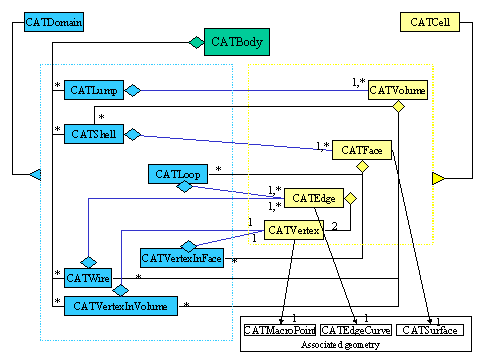
Geometric Modeler |
Topology |
The CGM Topological ModelHow the Topological Concepts are implemented |
| Technical Article | ||
AbstractThis article details how CGM V5 implements the concepts of the topology used to bound geometric objects. The topological operations are not handled here. First, the main interfaces (CATBody, CATDomain, CATCell) are presented, followed by their mutual relationships, and their validity range. The smart mechanism allowing to reuse topology from body to body is explained in a second part. The last part is more specific about the objects management. |
The Topological Objects interfaces allow to handle the body and all the types of topological domains and cells described in Topological Concepts. They give means to navigate through the topological graph, but do not operate bodies: the operations are brought by the TopologicalOperators interfaces.
[Top]
The CATBody interface implements the concept of topological body [2]. A CATBody is a geometric object, which handles a set of non necessarily connected cells and refers, directly or indirectly, all the cells needed for its construction. It offers tools to
The building up of a CATBody takes several steps
[Top]
CATDomain and CATCell interfaces implement the concept of topological domains and cells [2]. They offer navigation methods, and all Get and Set methods on their attributes.
The following arrays present the mapping between the concepts and the CGM interfaces.
| Space Dimension | Cell (concepts) | CATCell | Associated CATGeometry | Bounded by |
|---|---|---|---|---|
| 0 | Vertex | CATVertex | CATMacroPoint | |
| 1 | Edge | CATEdge | CATEdgeCurve | CATVertex |
| 2 | Face | CATFace | CATSurface | CATLoop, CATVertexInFace |
| 3 | Volume | CATVolume | CATShell, CATWire, CATVertexInVolume |
| Domain in 3D body (concepts) | CATDomain | Bounding | |
|---|---|---|---|
| 0 | VertexInVolume | CATVertexInVolume | CATBody, CATVolume |
| 1 | Wire | CATWire | CATBody, CATVolume |
| 2 | Shell | CATShell | CATBody, CATVolume |
| 3 | Lump | CATLump | CATBody |
| Domain in 2D body (concepts) | CATDomain | Bounding | |
| 0 | VertexInFace | CATVertexInFace | CATFace |
| 1 | Loop | CATLoop | CATFace |
The general object diagram is now presented.
 |
Notice:
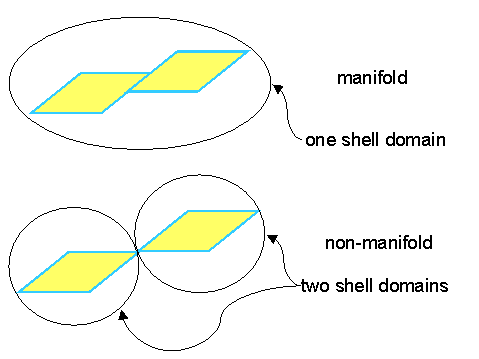 |
We discuss now on the relationships and relative orientations between these objects.
[Top]
A CATCell is a topological limitation of an underlying geometry (see also [3]).
The CATCell is oriented with regards to its underlying geometry.
CATOrientationNegativeCATOrientationPositiveCATOrientationUnknown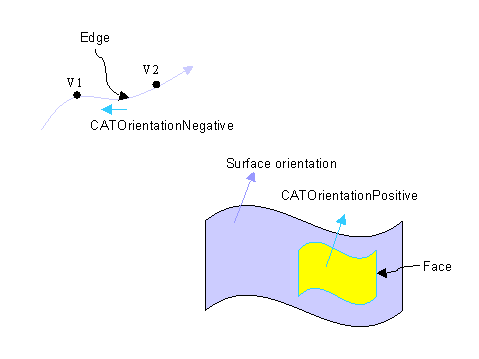 |
The edge V1-V2 is oriented from V2 to V1. Its orientation with regards
to the geometry is inverted (CATOrientationNegative)
Face has the same orientation as the orientation of the underlying surface. (CATOrientationPositive) |
[Top]
CATLocationInnerCATLocationOuterCATLocationFullCATLocationIn3DSpace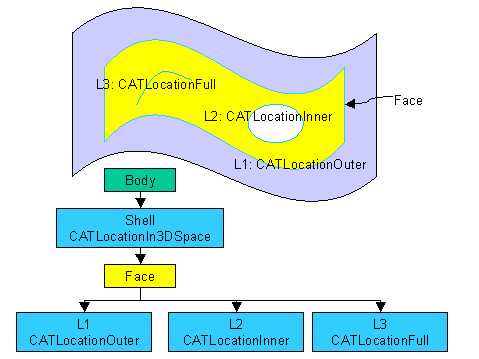 |
Face is bounded by 3 loop domains:
L1 is its external boundary: CATLocationOuter L2 is an internal loop: CATLocationInner L3 is an immersed loop: CATLocationFull |
[Top]
The relative orientation between the cell and its underlying geometry and the type of location of the boundaries are not sufficient to precisely defined the relationships between the cells. It remains to be declared on which side is the matter, when a bounding cell is run along.
The CATSide attribute defines the matter side on a bounding cell of a cell. This attribute is independent of the geometric orientation (CATOrientation), but must be consistent with the location (CATLocation).
| CATFace | CATEdge | CATVertex | ||
|---|---|---|---|---|
| CATVolume | CATSideLeft |
The face normal points inside the volume | Impossible | Impossible |
CATSideRight |
The face normal points outside the volume | Impossible | Impossible | |
CATSideFull |
The face is immersed into the volume | The edge is immersed into the volume | The vertex is immersed into the volume | |
| CATFace | CATSideLeft |
Standing along the face direction and watching in the direction of the edge leads to have the matter to your left. | Impossible | |
CATSideRight |
Standing along the face direction and watching in the direction of the edge leads to have the matter to your right. | Impossible | ||
CATSideFull |
The edge is immersed into the face | The vertex is immersed into the face | ||
| CATEdge | CATSideLeft |
The vertex is at the edge beginning | ||
CATSideRight |
The vertex is at the edge end | |||
CATSideFull |
Impossible |
[Top]
The CATEdges must always be appended inside an inner or outer CATLoop in the order found by letting the matter on the left side, when the you stand along the normal of the face. This is independent on the orientation of the CATEdge itself.
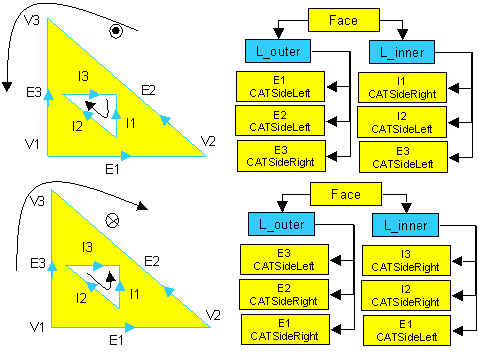 |
Top:
The order for defining the outer loop is E1, E2, E3 (or E2, E3, E1; or E3, E1, E2). All other order is wrong. The order for defining the inner loop is I1, I2, I3 (or I2, I3, I1; or I3, I1, I2). All other order is wrong. Bottom: The order for defining the outer loop is E3, E2, E1 (or E2, E1, E3; or E1, E3, E2). All other order is wrong. The order for defining the inner loop is I3, I2, I1 (or I2, I1, I3; or I1, I3, I2). All other order is wrong. |
Notice the CATSide attributes associated with the CATEdges.
A boundary cell operator always returns the CATCells in the order they have
been defined inside the CATLoop. When a cell bounds a domain twice, the boundary
cell operator returns the cell twice: once with theCATSideLeft
attribute, once with the CATSideRight attribute. This configuration ,
allowed by the CGM topological model, is however to avoid: some topological
operators does not hold it in a first version.
[Top]
A CATDomain is globally oriented. Each CATCell also owns its own orientation. It is the reason why it is necessary to set the CATOrientation of a CATCell with regards to the CATDomain that contends it. If this CATDomain is itself a boundary, it is equivalent to give the CATOrientation of the CATCell with regards to the CATDomain, or to define the CATSide of the CATCell (see the example of the cube below).
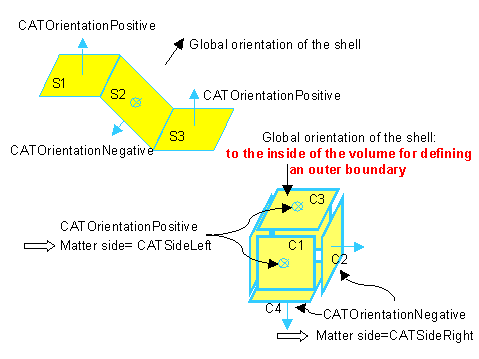 |
The global orientation of the shells are represented by the black
arrows.
The orientation of each face is drawn in light blue. The faces S2, C2, C4 must have the attribute CATOrientationNegative to keep the consistency of the shell domain. The matter side is then CATSideRight for the faces C2 and C4, and CATSideLeft for the faces C1 and C3 (no matter side for S1, S2, S3, that do not bound a CATDomain). |
[Top]
Do the following steps for managing the different orientations:
[Top]
The validity of the objects is checked at the CATBody completion. The CATBody cannot be frozen if one of the following rules is not fulfilled:
Hence, a cell must not be bounded several times by the same cell of lower dimension. For representing such objects, it will be necessary to use more than one cell .
[Top]
The topological model allows domains to share cells with other domains (in the same body or in different bodies). This property minimizes the model size. On the other hand, a cell may belong to several domains and bodies. Hence, it is necessary to precise the context of the body or the domain, for getting its parents.
This property is used by the topological operators. A toplogical operator often has frozen bodies as input operands. These bodis cannot be modified anymore. However, the topological operator exactly knows what it wants to modify. Then, it only duplicates the touched part of the body, and shares the untouched cells. For doing that, it uses a CATSmartBodyDuplicator.
The following example shows the Boolean difference between a cuboid and a cylinder that is totally included into the cuboid. In this case, all the faces of each initial body are shared with the resulting body.
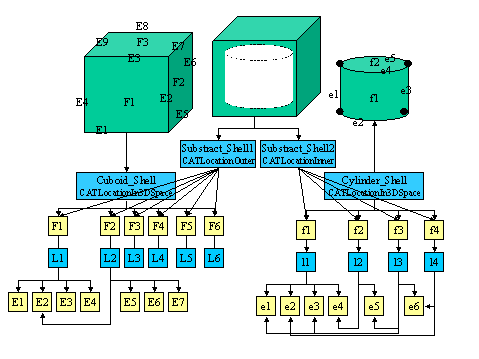 |
This figure illustrates the smart concept: the initial bodies are not
modified.
A new one is created, sharing existing topology. Notice that the boundaries of the upper and lower faces of the cylinder are made of two edges, for satisfying the validity rules about closed cells. |
[Top]
The object persistency is realized through the use of a document, that can be any user Document. A geometric container of CATGeoFactory type must be initialized to allow the creation of the geometric and topological objects.
[Top]
The CATGeoFactory is the factory of all geometric objects in general hence it is the factory of the CATBody, that is a geometric object.
[Top]
In turn, the CATBody allows to create CATCells and CATDomains of all dimensions inside a geometric container. These objects are however not directly attached to the CATBody that created them. Only the first level of domains will be directly related to the CATBody.
[Top]
Different tools allows to easily navigate though the topology.
[Top]
[Top]
| [1] | The CGM Objects |
| [2] | Topology Concepts |
| [3] | How to Associate Topology with Geometry |
| [Top] | |
| Version: 1 [Mar 2000] | Document created |
| [Top] | |
Copyright © 2000, Dassault Systèmes. All rights reserved.